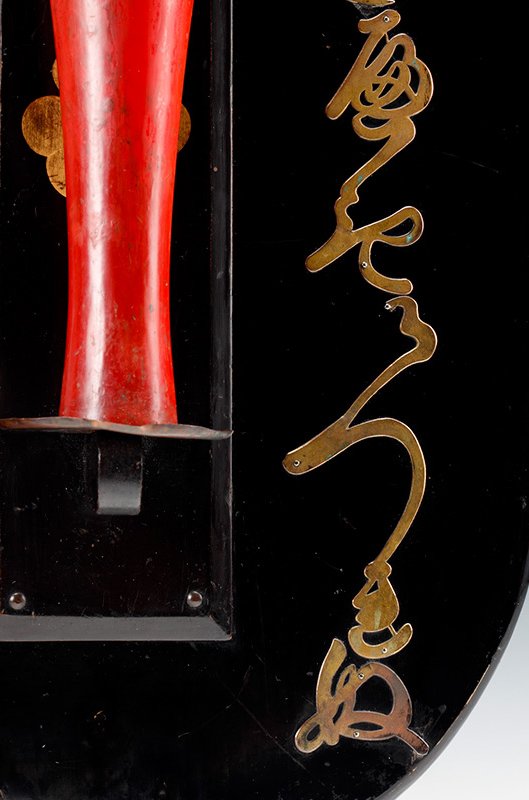TRADITIONAL ART
19th CENTURY, CANDLE SHOP KANBAN
Kanban or shop signboard for a candle shop, in the form of a large, ovoid gold Koban coin supporting a sculpted, three-dimensional candle, flanked by Chinese characters running down the left side and grass script on the right, and discretely behind the candle the owner’s plum blossom-form mon or family crest. The ovoid Koban-form base and the beveled rectangular mount for the candle of black lacquered wood (with the crest in gold lacquer); the candle of red lacquered carved wood; the Chinese characters and grass script in hand-chiseled brass attached with small, silver nails; the candle saucer of hammered copper; the supporting ring of hand-forged iron. Late Edo – early Meiji era, circa 1850 – 1870.
Very few of these figural kanban survive. This was made for display on the interior of the candle shop, behind the merchant’s account desk on the raised, wood-floored part of the establishment. From the costly materials used for this signboard (hand cut bras; silver nails; black, red and gold lacquers), we know that the kanban advertised a proud and successful establishment. Candles of course were costly and only wealthy merchants, priests and samurai could afford to light their evenings.
Note: condition excellent, with old, small surface cracks in the lacquer; some old lacquer repairs in the black lacquer at the bottom; and visible in the supporting wood from the reverse some old minor cracks to the wood base, one of which at the top was stabilized in the late 19th century with a small piece of ornamental copper hardware immediately back of the supporting iron. In other words, the condition is consistent with what should be expected of a signboard of this type and age that has been well cared for and not weathered out of doors.
19th Century, Candle Shop Kanban
Period: Edo & Pre-Edo
Mediums: Wood
Form: Kanban Shop Signs
Origin Country: Japan
24” high x 14 ¼” wide x 4 7/8” deep
This piece is no longer available.


